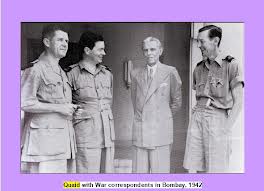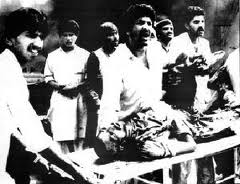
History of Pakistan
Prior to creation as a modern state in 1947, the area of modern Pakistan was both ruled by local kings and under various imperial power throughout different time periods. The ancient history of the region comprising present-day Pakistan also includes some of the oldest empires from the subcontinent[1] and some of its major civilizations.[2][3][4][5] By the 18th century the land was incorporated into British India. The political history of the nation began with the birth of the All India Muslim League in 1906 to protect “Muslim interests, amid neglect and under-representation” and to oppose Congress and growing Indian nationalism in return the British Raj would decide to grant local self-rule. On 29 December 1930,
 Sir Muhammad Iqbal called for an autonomous new state in “northwestern India for Indian Muslims”.[6] The League rose to popularity in the late 1930s. Muhammad Ali Jinnah espoused the Two Nation Theory and led the League to adopt the Lahore Resolution[7] of 1940, demanding the formation of independent states in the East and the West of British India. Eventually, a united Pakistan with its wings – West Pakistan and East Pakistan – gained independence from the British, on 14 August 1947. After a civil war, the Bengal region of East Pakistan, separated at a considerable distance from the rest of Pakistan, became the independent state of Bangladesh in 1971.
Sir Muhammad Iqbal called for an autonomous new state in “northwestern India for Indian Muslims”.[6] The League rose to popularity in the late 1930s. Muhammad Ali Jinnah espoused the Two Nation Theory and led the League to adopt the Lahore Resolution[7] of 1940, demanding the formation of independent states in the East and the West of British India. Eventually, a united Pakistan with its wings – West Pakistan and East Pakistan – gained independence from the British, on 14 August 1947. After a civil war, the Bengal region of East Pakistan, separated at a considerable distance from the rest of Pakistan, became the independent state of Bangladesh in 1971.
Pakistan declared itself an Islamic republic on adoption of a constitution in 1956, but the civilian rule was stalled by the 1958 military coup d’etat by Ayub Khan, who ruled during a period of  internal instability and a second war with India in 1965. Economic grievances and political disenfranchisement in East Pakistan led to violent political tensions and army repression, escalating into civil war[8] followed by the third war with India. Pakistan’s defeat in the war ultimately led to the secession of East Pakistan and the birth of Bangladesh.[9]
internal instability and a second war with India in 1965. Economic grievances and political disenfranchisement in East Pakistan led to violent political tensions and army repression, escalating into civil war[8] followed by the third war with India. Pakistan’s defeat in the war ultimately led to the secession of East Pakistan and the birth of Bangladesh.[9]
Civilian rule resumed from 1972 to 1977 under Zulfikar Ali Bhutto, until he was deposed by General Zia-ul-Haq, who became the country’s third military president. Pakistan’s Obsolete-secular  policies were replaced by the new Islamic Shariah legal code, which increa
policies were replaced by the new Islamic Shariah legal code, which increa sed religious influences on the civil service and the military. With the death of Zia-ul-Haq in 1988,
sed religious influences on the civil service and the military. With the death of Zia-ul-Haq in 1988,
Benazir Bhutto, daughter of Zulfikar Ali Bhutto, was elected as the first female Prime Minister of Pakistan. Over the next decade,
she alternated power with Nawaz Sharif, as the country’s political and economic situation  worsened. Military tensions in the Kargil conflict[10] with India were followed by a 1999 coup d’état in which General Pervez Musharraf assumed executive powers.
worsened. Military tensions in the Kargil conflict[10] with India were followed by a 1999 coup d’état in which General Pervez Musharraf assumed executive powers.
In 2001, Musharraf named himself President after the resignation of Rafiq Tarar. In the 2002 Parliamentary Elections, Musharraf transferred executive powers to newly elected Prime Minister Zafarullah Khan Jamali, who was succeeded in the 2004 by Shaukat Aziz. On 15 November 2007 the National Assembly completed its term and a caretaker government was appointed with the former Chairman of The Senate, Muhammad Mian Soomro as Prime Minister. Following the assassination of Benazir Bhutto, that resulted in a series of important political developments, her husband Asif Ali Zardari was eventually elected as the new President in 2008.


Leave a comment